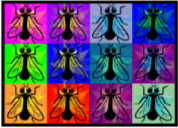- Escambia County Public Schools
- Biology End of Course Review
- SC.912.L.16.1 Genetics
Science
Page Navigation
- Home
- Elementary Science Curriculum
-
Biology End of Course Review
- Biology EOC Review
- SC.912.N.1.1 Scientific Method
- SC.912.L.18.12 Properties of Water
- SC.912.l.18.9 Photosynthesis and Cellular Respiration
- SC.912.L.18.1 Macromolecules
- SC.912.L.16.17 Mitosis and Meiosis
- SC.912.L.16.3 DNA Replication
- SC.912.L.14.3 Cell Structure
- SC.912.L.14.1 Cell Theory
- SC.912.L.17.20 Human Impact
- SC.912.L.17.9 Food Webs and Energy Transfer
- SC.912.L.17.5 Population Size
- SC.912.L.16.13 Reproductive System
- SC.912.L.16.10 Biotechnology
- SC.912.L.14.52 Immune System
- SC.912.L.14.36 Cardiovascular System
- SC.912.L.14.26 The Brain
- SC.912.L.14.7 Plant Structure
- SC.912.L.16.1 Genetics
- SC.912.L.15.13 Natural Selection
- SC.912.L.15.8 Origin of Life
- SC.912.l.15.6 Classification
- SC.912.L.15.1 Evolution
SC.912.L.16.1 Genetics
ORGANISMS, POPULATIONS AND ECOSYSTEMS
CLASSIFICATION, HEREDITY AND EVOLUTION
WHAT YOU NEED TO KNOW
-
- You need to know how to use Mendel's laws of segregation and independent assortment to analyze patterns of inheritance.
- You need to know how dominant, recessive, codominant, sex-linked, polygenic, and multiple allele modes of inheritance cause observed inheritance patterns.
EXAMPLE ONE
-
Hemophilia is a sex-linked, recessive trait. Which of the following describes the probability of hemophilia in the offspring of a man who does not have hemophilia and a woman whose father is a hemophiliac?
A. Each of their sons will have hemophilia.
B. None of their daughters will have hemophilia.
C. Their sons have a 25% chance of having hemophilia.
D. There is a 50% chance that their daughters will have hemophilia.
EXAMPLE TWO
-
Alleles for the A and B blood cell antigens are codominant. The condition where no antigens are present on the blood cells (type O blood) is a recessive trait. Which set of parents can most likely produce a child with type O blood?
A. one parent with type AB blood, and the other parent with type A blood
B. one parent with type AB blood and the other parent with type O blood
C. one parent with heterozygous type A blood, and the other parent with type O blood
D. one parent with homozygous type A blood, and the other parent with homozygous type B blood
EXAMPLE THREE
-
One of the parents of a child has phenylketonuria (PKU), which is caused by recessive alleles. The other parent does not have the PKU alleles. What is the chance that the couple will have a child with phenylketonuria?
A. 0%
B. 50%
C. 75%
D. 100%
EXAMPLE FOUR
-
Hitchhiker's thumb (H) is dominant to no hitchhiker's thumb (h). A woman who does not have hitchhiker's thumb marries a man who is heterozygous for hitchhiker's thumb. What is the probable genotypic ratio of their children?
A. 0% Hh: 100% hh
B. 50% Hh: 50% hh
C. 75% Hh: 25% hh
D. 100% Hh: 0% hh
EXAMPLE FIVE
-
This diagram shows a pedigree for a recessive genetic disorder.
What is the genotype of individual 6?
A. XHXH
B. XHXh
C. XHY
D. XhY
EXAMPLE SIX
-
This diagram shows a diploid cell with two pairs of homologous chromosomes.
Due to independent assortment, what is the possible genetic make-up of gametes produced by this organism?
A. SsTt
B. Ss, Tt
C. S, s, T, t
D. ST, St, sT, st
EXAMPLE SEVEN
-
The table lists the trials for fruit color where allele R exhibits incomplete dominance over allele R'.
Heterozygous fruit have orange phenotypes. What percent of offspring are expected to have an orange phenotype if the parent plants are orange (RR') and yellow (R'R')?
A. 25%
B. 50%
C. 75%
D. 100%
EXAMPLE EIGHT
-
Mendel hypothesized that reproductive cells have only one factor for each inherited trait. This hypothesis is supported by which observation?
A. Haploid cells are produced by mitosis.
B. Diploid cells are produced by mitosis.
C. Haploid cells are produced by meiosis.
D. Diploid cells are produced by meiosis.
EXAMPLE NINE
-
A human baby boy inherits a recessive allele from his mother. In which circumstance would he most likely show the trait coded for by the recessive allele?
A. The baby inherits the dominant allele from his father.
B. The allele is on an autosomal chromosome and the baby is a twin.
C. The allele is on the X chromosome.
D. The allele is on the Y chromosome.
INTRODUCTION TO HEREDITY
MENDELIAN GENETICS
PUNNETT SQUARE FUN
INCOMPLETE DPMINANCE, CODOMINANCE, POLYGENIC TRAITS
SEX-LINKED TRAITS
IN YOUR BOOK
-
General Biology - Sections 6.3-6.5, pgs. 177-187; Chapter 7, pg. 198
Honors Biology - Chapter 11, pg. 260





